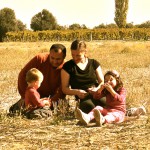By Rita Brhel, API’s publications coordinator, managing editor of Attached Family magazine and an API Leader (Hastings, Nebraska, USA). Originally published in the “Feeding Our Children” 2009 issue of Attached Family.
 My mother has a PhD in nutrition, and my father recently retired after 35 years in food production research. In addition to their food-oriented careers, we lived on a sustainable farm, meaning that we grew food for our own use, as well as to sell to others, in an environmentally and socially responsible way. So I was raised with an appreciation of food—both for the work that goes into growing it and for its capabilities in keeping our bodies healthy.
My mother has a PhD in nutrition, and my father recently retired after 35 years in food production research. In addition to their food-oriented careers, we lived on a sustainable farm, meaning that we grew food for our own use, as well as to sell to others, in an environmentally and socially responsible way. So I was raised with an appreciation of food—both for the work that goes into growing it and for its capabilities in keeping our bodies healthy.
I carried on this family legacy of responsibility in food production and consumption with an early journalism career in covering sustainable agriculture, connecting producers to consumers and chefs. For many years, until I became a mother and my personal and professional focus shifted to Attachment Parenting, I covered the “big names” in this genre of journalism.
Among the up and coming stars in this realm has been Cynthia Lair, a self-made whole foods chef turned author and cooking show host. This wonder woman of sorts has a lot going on, including:
· “Cookus Interruptus,” a web-based cooking show (www.cookusinterruptus.com) that teaches consumers how to cook fresh, local, organic, whole foods despite life’s interruptions.
· Feeding the Whole Family: Recipes for Babies, Young Children, and Their Parents, the book that started it all, and a second book, Feeding the Young Athlete: Sports Nutrition Made Easy for Players and Parents
· Instructor at Bastyr University’s School of Nutrition and Exercise Science in Kenmore, Washington
In my discussions leading up to this interview, published originally in the Attached Family magazine’s 2009 “Feeding Our Children” issue, Cynthia revealed how much influence that practicing Attachment Parenting with her daughter helped to shape her life—and especially started her on the path to becoming the force she is in encouraging others to try to embrace whole foods.
RITA: Thank you, Cynthia, for taking the time for this interview. Let’s start with what influenced you in embracing whole foods nutrition?
CYNTHIA: It’s a little Lifetime movie-ish. My mother was a cancer patient, and I wanted to help in some way. As I was researching, I learned about macrobiotics and its role in disease prevention and healing. Part of this approach calls for people to move toward more natural foods. I decided to leave behind the strict doctrinal part of it and went on with the more spiritual and natural tenets of it.
My diet prior to that had been a “diet” diet. I was surviving on cottage cheese, diet Coke, coffee and salad—always trying to lose weight. I was in my early 20s, and I’m in my mid-50s now, so it was a long time ago. I didn’t know anything.
After college, I began putting on weight and didn’t understand why. The only information at the time was doing a calorie count.
But it was good. Having gone through that as a person—I also had quite the sugar addiction as a child—I can understand that people can change.
RITA: The most passionate people for a movement tend to be those who’ve “been there, done that” in terms of changing. What does it take to change the way we think about food?
CYNTHIA: Many emotions go into the over 200 decisions about food we make every day. I’m the last to understand all of the reasons behind our decisions. Some choices are made from fear or wanting control. Some are made in an effort to be more spiritual or to heal. You have to understand why you are choosing the foods you choose before you can change. I learned much of this from Mindless Eating by Brian Wansink.
RITA: What inspired you to change specifically?
CYNTHIA: After my eyes were opened up to the nature of food and its healing potential, I went back to school in New York City at the Health and Nutrition Program to become a certified health and nutrition counselor.
During school, I focused all of my papers on maternal and infant nutrition. I was newly married, and we were talking about having a baby. This time in one’s life is such a window of opportunity to change how you eat and to learn how to eat. Every mother wants to make the right choices, the best choices they can.
After my daughter was born and it came time to start her on foods, the experiment began. I started feeding her what we were eating, instead of following the cultural rules at the time [store-bought baby food]. And I couldn’t get this book out of my head. Some of the book came from within me, but most of it came from practicality.
RITA: What do you hope to accomplish through your educational efforts in whole foods?
CYNTHIA: Through “Cookus Interruptus,” the point of the show is to demonstrate how to incorporate high quality, wholesome foods into the diet within the context of a busy family.
There’s a back story to the cooking show. The characters are Great-Grandpa, Grandpa, Grandma and the Mom, who is going through an identity crisis and is struggling to take care of her 5-year-old son so she has moved back home.
It’s an Attachment Parenting community. That’s all going on in there, during the show. It’s so subtle. It’s not a perfect family: We got problems, but the boy is being taken care of in a loving and respectful way. I’m very conscious of what kind of family values we’re presenting.
My goal is to move healthy eating away from the fringes and into the mainstream. I want ordinary people to realize that, yes, you can do this.
I thank U.S. President Barack Obama and First Lady Michelle for normalizing it through their garden and personal food choices. The more normal it is, the easier it is to get some of the more important things done, like getting healthier foods into school lunches and the hospitals and getting farm subsidies in place for growers of fruits and vegetables. It all starts, I believe, at the family dinner table.
RITA: A sit-down meal shared together is a great way for families to continue practicing the second of Attachment Parenting International’s Eight Principles of Parenting: Feeding with Love and Respect. Cynthia, can you explain the importance of the family table?
CYNTHIA: Research bears out that for the family that sits down and shares a meal together, the children have a long list of benefits, including closer family ties, better vocabulary, more resilience when facing emotional crisis—wow—and as teens, not going toward drugs and alcohol as much. Sitting down and eating together is nutritious in every way possible, which is why I believe babies should eat the same foods as the rest of the family.
RITA: You’ve told me that API’s Principle of Feeding with Love and Respect aligns so closely to your own beliefs that it could have come straight out of your book. Can you share with us a little about your journey in Attachment Parenting?
CYNTHIA: I’m not a Mother Earth-type person. I know many people who are, and some of them are good friends of mine, but I’m not. I was curious in raising a child, just like we all are.
When babies are born, their mothers have these incredible strings attached to their hearts from their child: You know when they’re going to cry before they do—that kind of thing. I was shocked by how strong that was.
I think mothers have to let go of some of those strings in order to go back to work full time. I couldn’t let go. I had all this creative energy, but I decided I didn’t have to give up one—my career or motherhood—for the other. I allowed both to nourish each other. I think that’s the heart of Attachment Parenting: allowing that bond to be. It’s not that I was giving up my life but instead I was allowing my life to shift. Once I became a teacher, I found that is a really good career for a parent. I never had to use daycare. That’s what I see as the soul of Attachment Parenting: being there.
You have to change the way you think, just like you do when learning to eat wholesome foods.
RITA: What advice would you give to someone who wants to change the way they think about food?
CYNTHIA: The most important thing is to make really small changes and to do these changes slowly. The people who clear out their cupboards are the ones who only last two weeks. For example, you could set the goal to serve dark leafy greens once a week. Do that for three, four, six months and then pick another goal.
RITA: What other goals would you recommend starting with?
CYNTHIA: The first small change I would suggest is to dump diet soda. This is mostly from personal experience, but on a related note, Walter Willett from Harvard University, author of Eat, Drink, and Be Healthy, explains that liquid calories don’t trigger the satiety signals. If you drink 300 calories from a latte, your body still thinks you need lunch.
Second, I would try to serve a warm breakfast once time a week. The easiest breakfast to serve kids is a sweetened or unsweetened cereal. Serving warm toast and eggs is a very loving thing you can do for yourself and your child.
Third, I would learn how to cook more vegetables that are pleasing to your family. Instead of steaming kale and trying to get everyone to choke that down, try serving it in a way your spouse and children would be more likely to eat it. Serve asparagus braised in butter and seasoned. Put cheese on broccoli.
RITA: Thank you so much for your time and your wisdom, Cynthia. Do you have any closing thoughts you’d like to share?
CYNTHIA: One thing I love about the API’s Principle of Feeding with Love and Respect is the word “respect” and its far-reaching implications. That word is important and has a lot of ripples to it: We want to respect ourselves through the food we eat, we want to respect the food by presenting it attractively, we want to respect the work that goes into preparing it, and we want to respect the people who grew the food and brought it to us. Most of all, we want to respect our children by teaching them to eat good food and to respect the people who make the food.
Be Mindful When Feeding Ourselves, Our Children by Cynthia Lair
· Let an appetite develop – Constant sipping on juices and nibbling on crackers can lead to picky eating at the table. Physical activity is important.
· Help discover intuition about what the body needs – When your child says, “I’m starving,” ask which food sounds better: this or that.
· Know what you are serving – not just what the ingredients are but where it came from, how thefood was grown and processed. Whenever possible, choose fresh, local, organic ingredients. Choose whole food (apple) over partial products (apple juice).
· Instill positive energy into the food you serve yourself and your children – Cook when possible, and pay attention to presentation; create flavor and beauty.
· Encourage sitting down to eat – In this way, the body is cued that eating and digesting are taking place and nutrient uptake is actually better. Also, most are satisfied with less food.
· Express gratitude together – Labor was expended in order for you to eat. The miracle of growth from a seed, dirt, water and sunshine occurred.
Shopping for Sustenance by Cynthia Lair
This could easily be the mantra guiding whole foods eating. If you purchase a food that was grown locally and organically, and is fresh and in season, that’s as good as it gets.
High-quality food is more expensive, but consider this: In the 1960s, American families spent 18% of their income on food and 5% on health care. Nowadays, this is reversed: We spend just 9% of our hard-earned dollars on food and 16% on health care. Which would you rather spend your money on?
Fresh
Fresh is best. The chemical composition of food changes radically a few hours after harvest simply because it is cut off from its food and water supply. Fresh food, particularly fresh produce, gives us maximum nutrients and flavor.
Frozen food can be good, too. Most of the nutrients are retained in foods that are frozen; however, some of the enzymes, color and flavor will have disappeared. If purchasing frozen fruits and vegetables, the texture will have changed. The foods are much less crisp than fresh foods because the cell structure is damaged by crystallization of water.
Canned foods have most of their nutrients present, but the flavor, color and texture suffer. One exception is tomatoes, which are picked at maximum ripeness and canned the same day. Often a canned tomato will be superior in flavor than a fresh tomato purchased in February that was flown thousands of miles.
Local
Did you know that 86% of our fruits, nuts and vegetables are grown on farms surrounding America’s cities? Most farmers who sell their food locally don’t artificially treat crops to withstand shipping and extend their shelf life. Have a conversation with some of the non-organic vendors at your local farmer’s market, and you may find out that some local farmers do not use synthetic fertilizers or pesticides but lack the size or profits to go through the rigorous process to attain organic status. Many farmers will sell their eggs, beef and pork directly to the consumer. The same is true for milk and milk products from healthy cows and goats.
Check out www.eatwild.com and click on your state. Consider subscribing to a CSA (Community-Supported Agriculture) operation through which a box of fresh, locally grown produce is delivered or picked up every week. The site www.localharvest.org has listings.
As Barbara Kingsolver pointedly reminds us in her essay, “Lily’s Chickens”:
“Even if you walk or bike to the store, if you come home with bananas from Ecuador, tomatoes from Holland, cheese from France and artichokes from California, you have guzzled some serious gas. This extravagance that most of us take for granted is a stunning boondoggle: Transporting five calories’ worth of strawberry from California to New York costs 435 calories of fossil fuel.”
Buying locally supports your community, supports your health and supports the intention of conserving global resources.
Organic
Buying organic products is a form of voting. Your organic purchase says that you support the growers and manufacturers who are producing food without the use of the synthetic fertilizers, insecticides, fungicides, herbicides or pesticides that pollute your body and your world.
Buying organic produce, especially locally grown produce, also helps keep you in tune with the seasons.
Many believe that organic produce tastes better and contains more nutrients.
We have national (U.S.) standards for labeling food “organic.” A label that says “100% Organic” must contain all organic ingredients. If the label simply says “organic,” at least 95% of the ingredients are organically produced. When the label reads “made with organic ingredients,” at least 70% of the ingredients are organic. Organic produce label codes start with the number nine.
Please be aware that before there were national standards set for labeling a food “organic,” the term meant that the product had been grown according to strict uniform standards and verified by independent state or private organizations. In constructing national regulations, the standards have been watered down some. Now that super-chains, like Wal-Mart, are carrying organic produce, the standards may be changed to benefit large producers over individual consumers. The large corporations have more lobbying power to get the regulations changed to suit their need for lower prices and bigger profits. This trend may put the small, local farmers out of business, so whenever possible, buy organic produce at your local farmer’s market rather than chain supermarkets.
Make a special effort to use organic products when preparing food for pregnant or nursing moms, infants and children. Toxins found in the mother’s food can cross the placenta to the growing fetus or wind up in breastmilk. What may be tolerated by a mature adult may prove harsh to the immature system of fetus or infant. Regulatory practices used to control pesticides in foods are based on studies of pesticide exposure to the general population without regard to the special needs of infants.
Some of the most pesticide- saturated foods are ones that we routinely give children to snack on, including peanut butter, peanuts, raisins and potato chips. Non-organic apples, peaches, strawberries and celery can contain as many as 80 pesticide residues. Use your power as a consumer to demand the best for our children, our planet and the future of both.
Seasonal
Choosing food that is in season gives the year rhythm and ritual. It is exciting to wait for local strawberries to appear, which are sweeter and fresher than eating Mexican-grown berries in January. Anticipation is a wonderful feeling. I can’t wait for corn to be in season locally because it is so sweet it hardly needs to be cooked. By waiting for produce available locally only during windows of time, our eating has a cyclical feeling keeping us in tune with the seasons.
Eating seasonally also puts your body in tune with the climate you are living in. The stereotypical southern Californian preference for raw salads and avocados has sense to it. The lighter diet that includes lots of raw foods is perfect for living in a sunny, warm climate. Northwesterners need the density of frequent servings of salmon to survive the cold damp of rainy winters. Traveling north of our continent, an even fattier diet is appropriate for surviving the cold. Where do you live? What did the ancestors who inhabited your community grow and eat?
Excerpted from Feeding the Whole Family by Cynthia Lair (Sasquatch Books, 2008). Reprinted with permission.
You might also enjoy the other articles in our National Nutrition Month series:
Kids in the Kitchen: An Interview with Sally Sampson, Founder of ChopChopKids
Malnourished by a Western Diet, or NDD by Dr. William Sears
Strengthening Secure Attachment Through Food by Kelly Bartlett
 Four in 10 babies don’t develop the strong emotional bonds–what psychologists call “secure attachment”–with their parents that are crucial to success later in life. Disadvantaged children are more likely to face educational and behavioral problems when they grow older as a result, new Sutton Trust research finds today [21 March].
Four in 10 babies don’t develop the strong emotional bonds–what psychologists call “secure attachment”–with their parents that are crucial to success later in life. Disadvantaged children are more likely to face educational and behavioral problems when they grow older as a result, new Sutton Trust research finds today [21 March].









